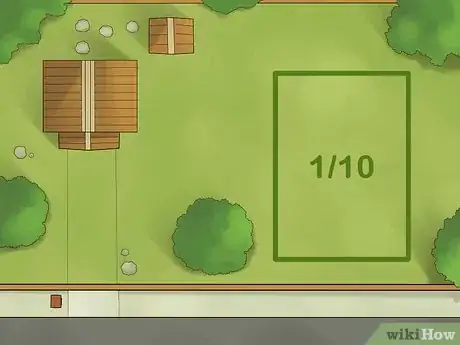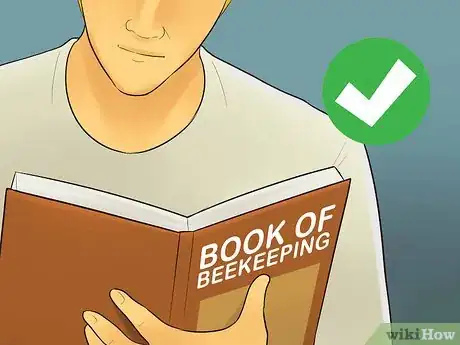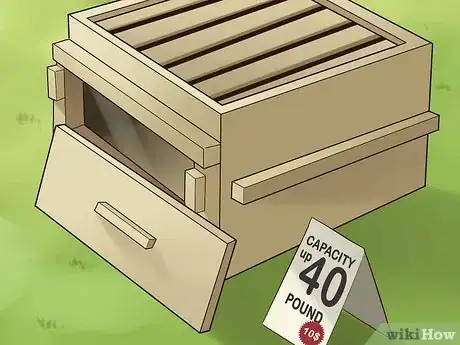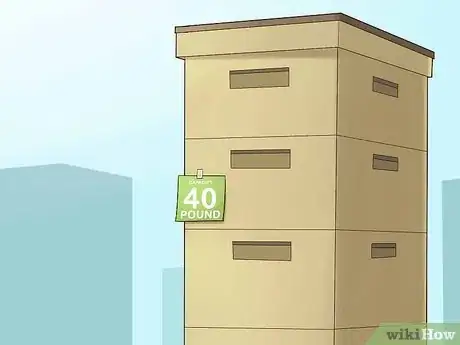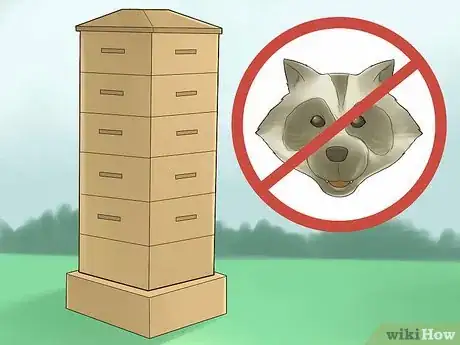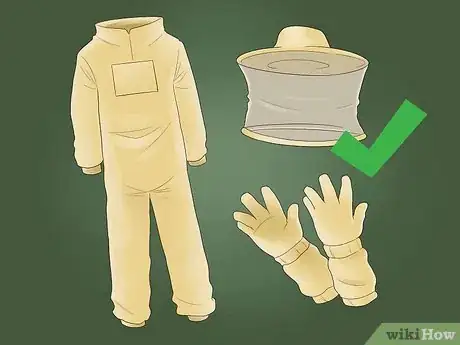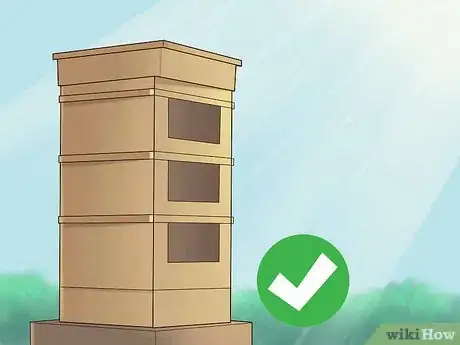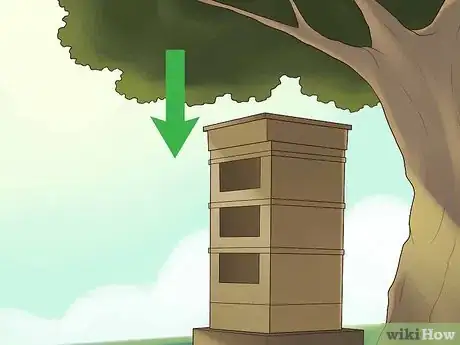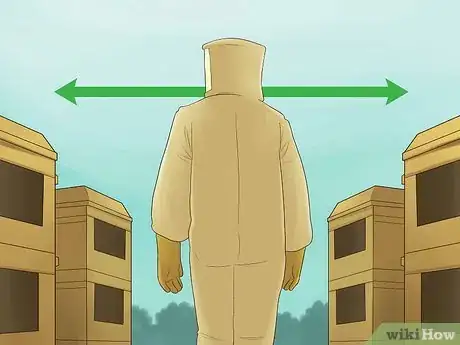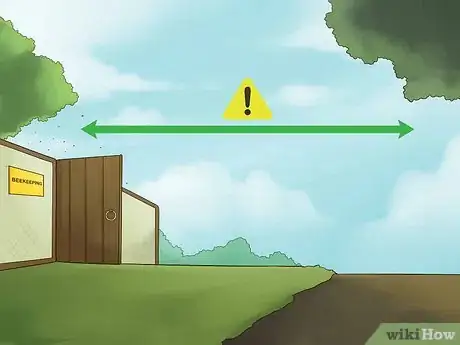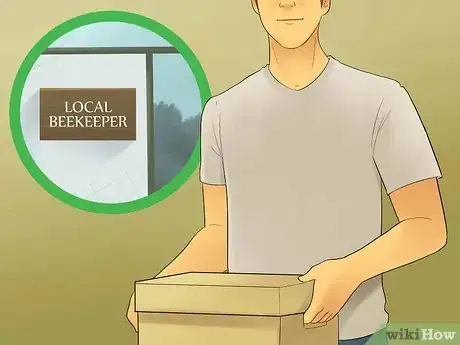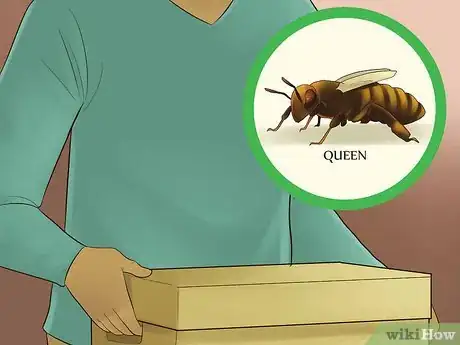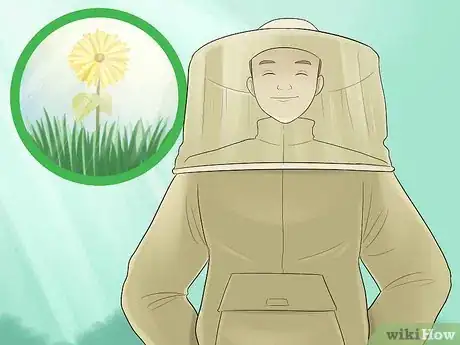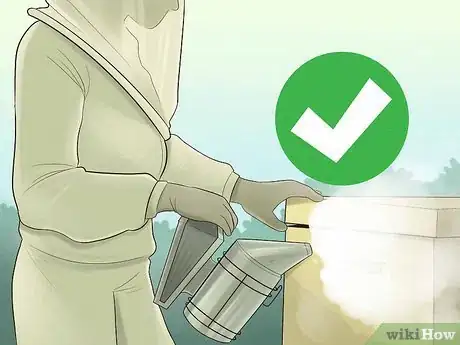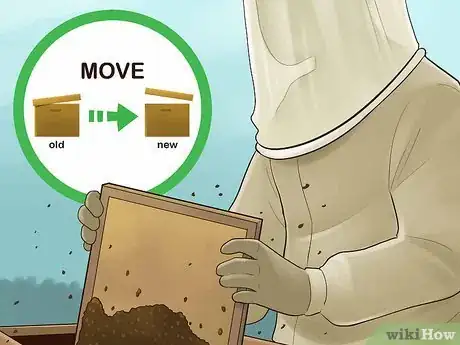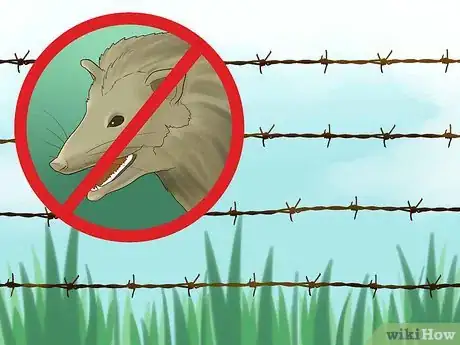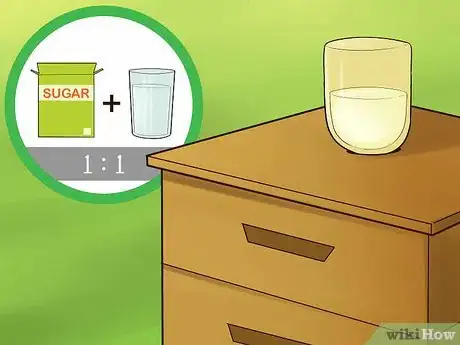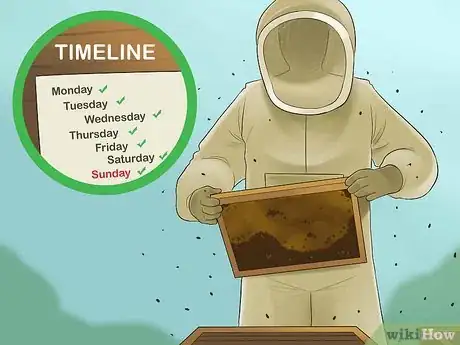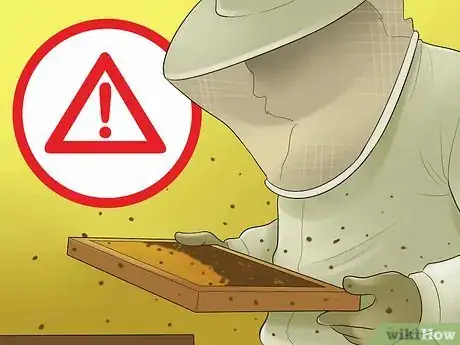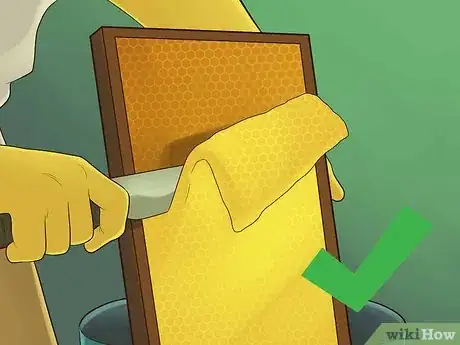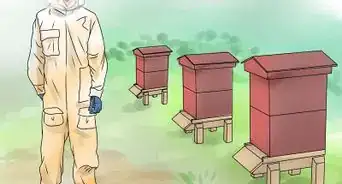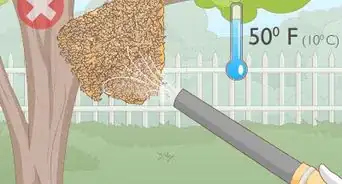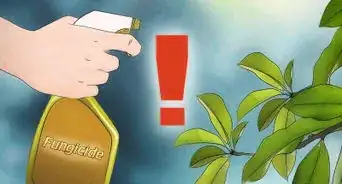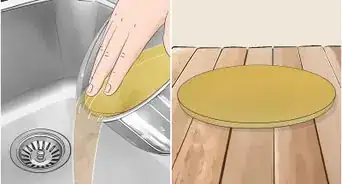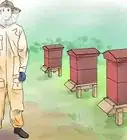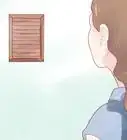This article was co-authored by David Williams. David Williams is a Professional Beekeeper and Bee Removal Specialist with over 28 years of beekeeping experience. He is the Owner of Bzz Bee Removal, a bee removal company based in the San Francisco Bay Area. Bzz Bee Removal locates, captures, and transports bees to local beekeepers to prevent colony collapse disorder.
There are 14 references cited in this article, which can be found at the bottom of the page.
wikiHow marks an article as reader-approved once it receives enough positive feedback. This article received 12 testimonials and 85% of readers who voted found it helpful, earning it our reader-approved status.
This article has been viewed 130,782 times.
Beekeeping can be a very fun and rewarding activity for you, your family, and friends. Not only does it let you eat fresh honeycomb, but it can also benefit your garden through pollination. It can take some time to put together a bee community, but once you do, beekeeping is relatively easy. You can get started beekeeping by putting together your hive, introducing the bees to the hive, and caring for the bee community.
Steps
Making Arrangements for Your Hive
-
1Ensure that you have at least 1/10th of an acre land. Consult the documents related to your property to find out the size of your yard. A typical city-sized lot is about one-tenth of an acre and can accommodate one bee colony. Make your determination of how many colonies to have based on the size of your yard.[1]
- Make sure the space has a clear flight path for the bees so that you don’t interrupt their ability to thrive.[2]
-
2Check local laws. Ask local officials, a county extension, or a beekeeping association about ordinances related to bee colonies. Ask questions about regulations on things such as how many hives you can have and the minimum amount of space between hives and your property line. This can prevent you from violating city codes or having to pay fines.[3]
- Find your local beekeeping association through the websites of national or state groups such as the Florida State Beekeepers Association or the British Beekeepers Association.[4] County extensions have offices in every state of the United States. You can find your local county extension at http://npic.orst.edu/pest/countyext.htm.
Advertisement -
3Start beekeeping projects in the autumn. Bees’ behavior is entirely dependent on climate. Use the fall and winter to consult books on beekeeping, gather your supplies to build the hive, and find a source for your bees. Introduce your bees to the hive only in the spring as the early flowers appear. Beginning your project during the autumn months ensures your bees can collect nectar and pollen to build a strong hive in the spring and summer.[5]
-
4Purchase a top bar hive if you want something lightweight. Find a local beekeeping supplier that sells 10-pound (4.5kg) top bar hives. This type of hive can make beekeeping fun and easy if you:[6]
- Want a hive that weighs less than 40 pounds (18kg)
- Want one or two hives
- Are willing to perform regular maintenance
-
5Get a Warre hive. Visit your local beekeeping supply store to look at Warre hives. Ask the salesperson any questions you have about Warre hives or if it is something best suited to your needs. Warre hives are good choices for hives if you:[7]
- Are ok with lifting 40 pounds or more
- Want one or two hives
- Want to perform occasional maintenance
- Want to see your bees in action
-
6Buy a Langstroth hive. While you’re at your local store, compare Warre hives with Langstroth hives. Ask the shop staff if a Langstroth hives may be better suited to your needs and wishes for beekeeping. Langstroth hives are a fun and great choice if you:[8]
- Are wiling to lift 40 pounds or more
- Want many hives
- Want to perform occasional maintenance
- Don’t necessary want to see your bees in action
-
7Construct a hive stand. Purchase a hive stand or build one with concrete blocks to keep your hive off of the ground. Measure to ensure that the hives are at least 18 inches off of the ground. This can protect them from critters such as skunks or raccoons and make it easier to check the hives. It also protects your back from having to lift heavy hives.[9]
-
8Get hive tools. Having basic protective clothing and tools can help you maintain your bee colony and protect yourself. Get the following hive tools and articles to wear while beekeeping:[10]
- Bee suit with gloves or simple hat and veil and lightweight jacket
- Smoker to calm the bees when you’re working in the hive
- Hive tool, which is a mini pry bar specifically used in beekeeping
Placing Your Hives in the Optimal Location
-
1Expose your hive to the morning sun. Put your hive in an area that gets sun in the mornings. This ensures that your bees get out of their hive early to forage for pollen. Place the hive in a spot that gets the full sun if you live in cooler climates such as the northeastern United States. Put the hive in a place with afternoon shade if you live in warmer climates.[11]
-
2Protect your hives from direct wind. Keep your hive away from open spots that are exposed to direct winds or breezes. Instead, set it next to wind breaks such as fences, shrubbery, trees, or bushes. This can ensure the health and vitality of your bees and minimize the risk of the hive tipping over.[12]
- Place hive entrances facing south or southeast if you live in the northern United States or Canada to protect it from winter winds.
-
3Space your hives at least one body width apart. Set the hives so that you can easily walk between them without grazing yourself. Spacing your hives comfortably apart will allow you greater movement while you work. It also minimizes the risk that bees perceive your presence as a threat.[13]
-
4Face hive entrances away from foot traffic. Position your hive entrance facing away from people or animals that may walk past it. Keeping your bees away from foot traffic minimizes the risk that your bees perceive animals or people as possible threats.[14]
Introducing the Bees into the Hive
-
1Source your bees early in the year. Select a local beekeeper, gardening or pet store where you can purchase your bees by January or February. Contact several different sources so that you have backup bees if anything falls through with your chosen supplier. Making sure you have a source for bees ensures that you can introduce them to the hive when plants start blooming.[15]
-
2Purchase a “nuc.” Ask your supplier to provide you with a “nuc.” This is a queen bee and a bunch of workers that are ready to place in the hive once spring starts.[16] If this isn’t an option, buy a confirmed queen bee and about 10,000 individual workers, which equals about three pounds of bees.[17] Introducing a nuc into a hive is easier than searching for an individual queen bee and thousands of workers.
-
3Put on your beekeeping gear. Once it’s spring and you have a nuc, put on your beekeeper suit, gloves, hat, and veil. Make sure anyone else who will handle or be near the bees is also wearing protective beekeeping gear. This can ensure you, your loved ones, and even your bees stay safe and happy when introducing the colony or performing regular maintenance.[18]
- Have spare beekeeping gear on hand if you have interested friends or family members.
-
4Smoke the bees out of the nuc. Puff your nuc with two or three wafts of cool smoke. Then place the nuc next to or on top of your hive. Using cool smoke and moving the nuc near the hive can wake up your bees and ensure a quick transfer into their hive.
-
5Release the bees into the new hive. Remove the outer and inner cover of your hive body. Then take off the frames from the nuc and gently center them in the hive body. Allow your bees to populate their new hive before replacing the inner and outer hive body covers.
- Check for any lingering bees in the nuc container and release them into your hive.
- Shake your nuc into the hive if you prefer a faster and easier transfer of your bees.
Caring for Your Bee Community
-
1Ensure your bees’ safety from critters with barriers. Winnie the Pooh and his bear friends aren’t the only animals who like honey. Protecting your bees from predators can ensure the vitality of your colony and a fruitful harvest. Use the following solutions to keep bee predators at bay:[19]
- Put up electric barriers or chicken-wire fences to keep bears, opossums, and skunks away.
- Elevate hives to keep opossums and skunks out of the hives.
- Place birdfeeders away from hives.
-
2Feed your bees as necessary. There may be a slight gap in time between when you introduce your bees to their hive and plants begin producing nectar. During these few weeks, feed your bees with a 1:1 mixture of water and sugar. Punch holes in the top of the hive and hang small food jars with the mixture from them. This can ensure your bees have nutrition until they can access nectar.[20]
-
3Monitor the hive at regular intervals. Check the hive as often as you like. This could be once between spring introduction and fall harvesting or every day if you prefer. This can ensure your hive is flourishing, building a strong comb, and doesn’t have any pests or other problems.[21]
-
4Watch for potential problems. During your check-ups of the hive, look for signs of illness, parasite infestation or other animals accessing your hive. This can help you nip potential problems in the bud before they affect your hive. Some signs of issues with your hive include:[22]
- Misplaced bars
- Weakened colony
- Visible hive beetles or wax moths on the comb
- Lack of larvae
- Deformed wings
-
5Harvest Honey. Take out the long, flat hive frames in the fall. Scoop off the honeycomb and wax into a container or bucket with a hot knife. Then allow the honey to gradually sink to the bottom of the container and remove the wax cappings that remain. This will give you delicious, raw honey to eat and wax cappings you can turn into candles or other items.[23]
- Set the wax capping on a sieve or filter to strain out bits of the capping from the raw honey.
- Get an extractor if you prefer to strain your honey into a spigot and keep the wax separate.
Expert Q&A
Did you know you can get expert answers for this article?
Unlock expert answers by supporting wikiHow
-
QuestionShould a beehive be in sun or shade?
 David WilliamsDavid Williams is a Professional Beekeeper and Bee Removal Specialist with over 28 years of beekeeping experience. He is the Owner of Bzz Bee Removal, a bee removal company based in the San Francisco Bay Area. Bzz Bee Removal locates, captures, and transports bees to local beekeepers to prevent colony collapse disorder.
David WilliamsDavid Williams is a Professional Beekeeper and Bee Removal Specialist with over 28 years of beekeeping experience. He is the Owner of Bzz Bee Removal, a bee removal company based in the San Francisco Bay Area. Bzz Bee Removal locates, captures, and transports bees to local beekeepers to prevent colony collapse disorder.
Beekeeper & Bee Removal Specialist Pick a spot that gets morning sun. Place your hive in an East-facing spot that the sun will hit first thing in the morning. Warming the hive early in the day is important for incubation because the temperature of the hive has to be 80° in order for the eggs to hatch. In addition, keeping the hive warm will help protect against issues with mold and bugs.
Pick a spot that gets morning sun. Place your hive in an East-facing spot that the sun will hit first thing in the morning. Warming the hive early in the day is important for incubation because the temperature of the hive has to be 80° in order for the eggs to hatch. In addition, keeping the hive warm will help protect against issues with mold and bugs. -
QuestionAre ants bad for beehives?
 David WilliamsDavid Williams is a Professional Beekeeper and Bee Removal Specialist with over 28 years of beekeeping experience. He is the Owner of Bzz Bee Removal, a bee removal company based in the San Francisco Bay Area. Bzz Bee Removal locates, captures, and transports bees to local beekeepers to prevent colony collapse disorder.
David WilliamsDavid Williams is a Professional Beekeeper and Bee Removal Specialist with over 28 years of beekeeping experience. He is the Owner of Bzz Bee Removal, a bee removal company based in the San Francisco Bay Area. Bzz Bee Removal locates, captures, and transports bees to local beekeepers to prevent colony collapse disorder.
Beekeeper & Bee Removal Specialist
-
QuestionHow do I get started with bees?
 David WilliamsDavid Williams is a Professional Beekeeper and Bee Removal Specialist with over 28 years of beekeeping experience. He is the Owner of Bzz Bee Removal, a bee removal company based in the San Francisco Bay Area. Bzz Bee Removal locates, captures, and transports bees to local beekeepers to prevent colony collapse disorder.
David WilliamsDavid Williams is a Professional Beekeeper and Bee Removal Specialist with over 28 years of beekeeping experience. He is the Owner of Bzz Bee Removal, a bee removal company based in the San Francisco Bay Area. Bzz Bee Removal locates, captures, and transports bees to local beekeepers to prevent colony collapse disorder.
Beekeeper & Bee Removal Specialist
Warnings
- Use entrance reducers over the winter to prevent mice and other critters from getting into the hive while the bees are less active.⧼thumbs_response⧽
- If you are allergic to bees, think seriously before deciding to keep them. If you understand the risks but want to keep bees anyway, be sure to keep an epi-pen handy in case you do get stung.⧼thumbs_response⧽
- Don't try to work with your bees on a cloudy, windy, or rainy day unless you absolutely have to. They get grumpy when the weather is bad and you are much more likely to get stung.⧼thumbs_response⧽
References
- ↑ http://www.popularmechanics.com/home/lawn-garden/how-to/g56/diy-backyard-beekeeping-47031701/
- ↑ http://www.beesbros.com/how-to-keep-bees.html
- ↑ http://www.beesbros.com/how-to-keep-bees.html
- ↑ https://www.bbka.org.uk/about/local_associations/find_an_association.php
- ↑ https://www.beethinking.com/pages/beekeeping-for-beginners
- ↑ https://www.beethinking.com/pages/the-best-bee-hive
- ↑ https://www.beethinking.com/pages/the-best-bee-hive
- ↑ https://www.beethinking.com/pages/the-best-bee-hive
- ↑ http://www.popularmechanics.com/home/lawn-garden/how-to/g56/diy-backyard-beekeeping-47031701/
- ↑ http://www.popularmechanics.com/home/lawn-garden/how-to/g56/diy-backyard-beekeeping-47031701/
- ↑ http://www.keepingbackyardbees.com/8-proper-beehive-placement-tips/
- ↑ http://www.keepingbackyardbees.com/8-proper-beehive-placement-tips/
- ↑ http://www.keepingbackyardbees.com/8-proper-beehive-placement-tips/
- ↑ http://www.keepingbackyardbees.com/8-proper-beehive-placement-tips/
- ↑ https://www.beethinking.com/pages/beekeeping-for-beginners
- ↑ https://www.beethinking.com/pages/beekeeping-for-beginners
- ↑ https://www.beethinking.com/pages/where-to-get-bees
- ↑ http://www.beesbros.com/how-to-keep-bees.html
- ↑ http://www.seriouseats.com/2014/08/how-to-raise-bees-honey-beekeeping-introduction.html
- ↑ http://www.beesbros.com/how-to-keep-bees.html
- ↑ http://www.beesbros.com/how-to-keep-bees.html
- ↑ http://www.beesbros.com/how-to-keep-bees.html
- ↑ http://www.beesbros.com/how-to-keep-bees.html
About This Article
To start beekeeping, first you'll need to get a hive from a local beekeeping supplier. You'll also want to get a bee suit for protection, a smoker for calming the bees, and a hive tool for reaching inside the hive. Once you have all of your supplies, set up your hive in a sunny location to encourage the bees to come out early in the morning for pollen. When you're equipment is set up, visit your local pet store or beekeeping supplier and purchase a nuc of bees, which is a queen bee and a group of workers ready to go into the hive. For tips on how to identify problems with your bees, read on!
